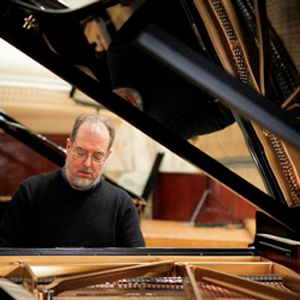by Daniel Hathaway

Variously described as “a thundering vehicle for virtuosity” (Michael Oliver in Gramophone), “monstrously overcomposed” (Alfred Brendel), “gaudy, unapologetically over-the-top” (Alex Ross), and — my favorite — “a boa constrictor of a piano concerto” (Raymond Tuttle, Classical Net), Busoni’s work is a long haul for the soloist, who plays almost continuously for 70 minutes. Also for the audience, whose ears have already filled up with notes halfway through, and for the men’s chorus, who sit patiently onstage for an hour before declaiming a hymn to Allah.
On Thursday evening, guest conductor Alan Gilbert led a tight performance of a work that continuously threatens to become formally unruly, and Ohlsson was indefatigable, cascading up and down the keyboard in what was often less of a real solo part than busy filler. He revelled in his task, making even pianistic bloviation sparkle and seem important.
The work itself, originally projected in seven movements but later whittled down to five, is like an encyclopedia of 19th-century musical styles. Given a list of prominent composers of the period, you could check off who had serially influenced Busoni as the piece unfolded. Some interesting orchestrational moments emerged from time to time out of its colorful but almost continuously turbid texture, but this is a score that even The Cleveland Orchestra couldn’t make more than translucent.
In the concerto’s final moments, the tenors and basses of the Cleveland Orchestra Chorus, prepared by Lisa Wong, rose in unison to sing Adam Ohlenschläger’s hymn from the 1805 play Aladdin. Divided into six voice parts, the singers created a splendid wall of chordal tone. Busoni wanted them offstage and out of sight, which might have produced an interesting effect, but it was equally thrilling to have them out in the open.
What do you pair with such a rangy and undisciplined work as the Busoni? Well, Haydn, of course, and Gilbert and a reduced orchestra opened the evening with his 100th Symphony, dubbed the “Military” for its several sudden appearances of percussion instruments.
The symphony is full of surprises and witty jokes, all of which Gilbert and the ensemble lifted up in their pristine performance. If a few interpretational gestures seemed overly-precious, the winds outdid themselves in the first movement, and the total effect was splendidly Apollonian — a delightful amuse-gueule before a heavy main course.
Published on ClevelandClassical.com February 12, 2019.
Click here for a printable copy of this article



